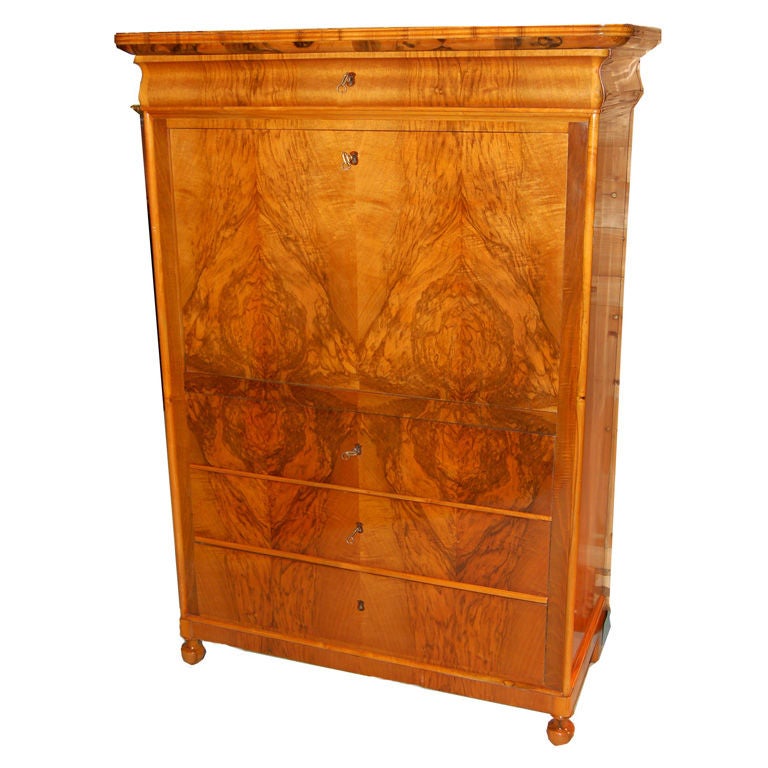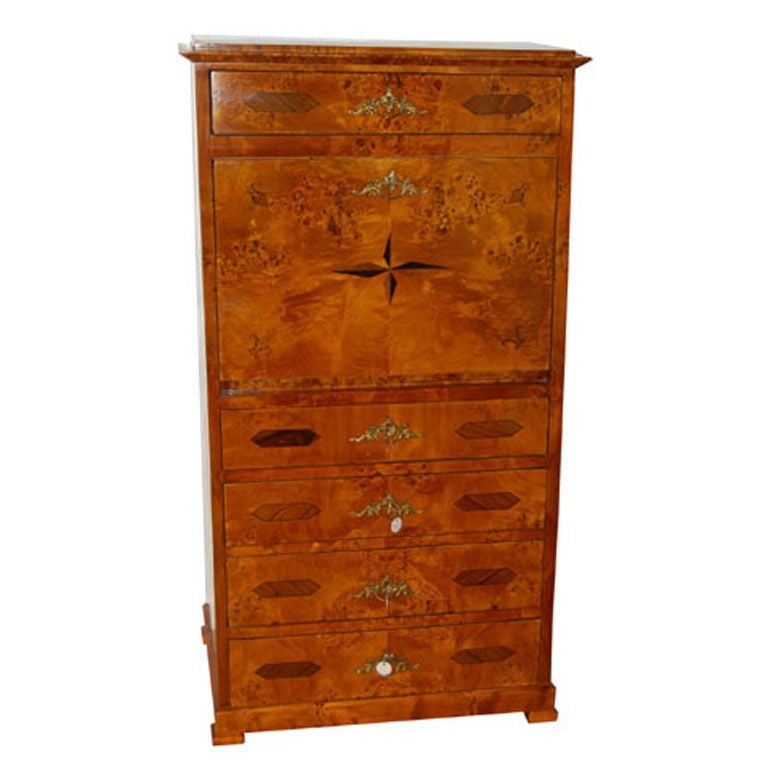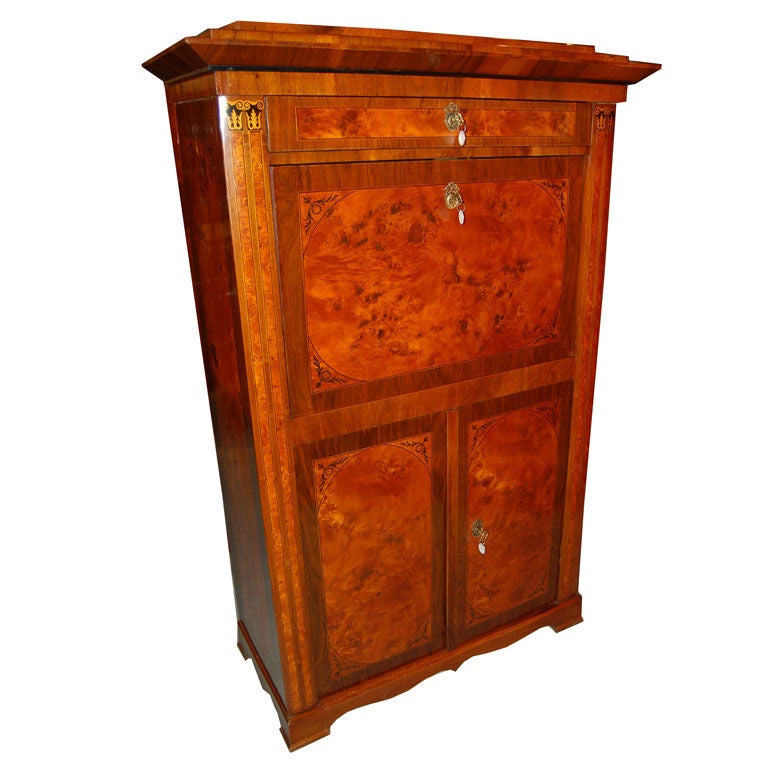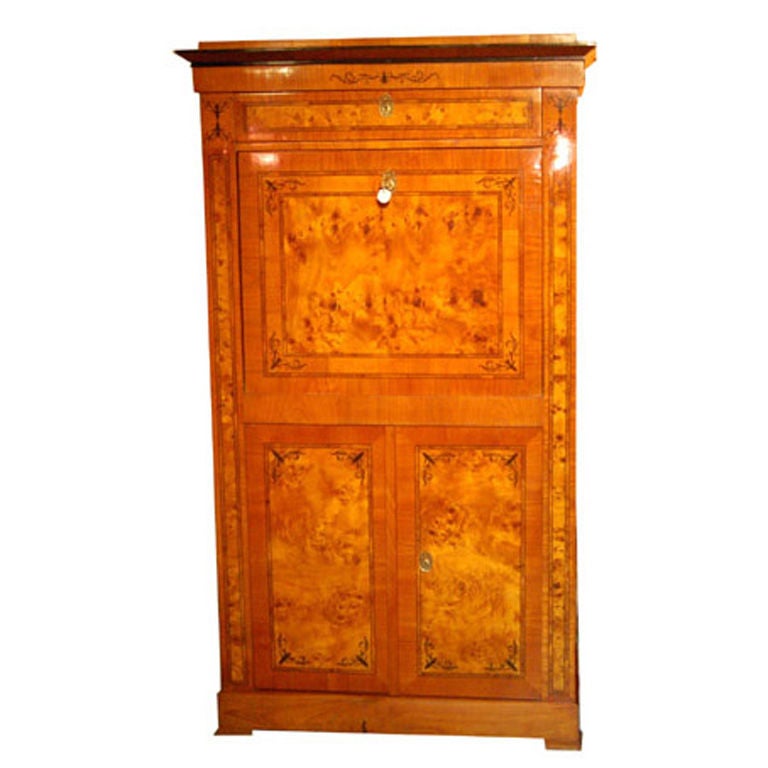Items Similar to Empire Secretaire
Want more images or videos?
Request additional images or videos from the seller
1 of 6
Empire Secretaire
About the Item
Empire Secretaire made of walnut and root wood with brass capitals and hardware. Three exterior drawers. Fall front writing surface w/five interior drawers and mirrored cubby hole. Ebonized and precious woods inside. Austria circa 1810.
- Dimensions:Height: 60 in (152.4 cm)Width: 33 in (83.82 cm)Depth: 19 in (48.26 cm)
- Place of Origin:
- Period:
- Date of Manufacture:circa 1810
- Condition:
- Seller Location:Pompano Beach, FL
- Reference Number:
About the Seller
5.0
Vetted Seller
These experienced sellers undergo a comprehensive evaluation by our team of in-house experts.
Established in 2004
1stDibs seller since 2009
66 sales on 1stDibs
Typical response time: 19 hours
- ShippingRetrieving quote...Ships From: Pompano Beach, FL
- Return PolicyThis item cannot be returned.
More From This SellerView All
- Biedermeier SecretaireLocated in Pompano Beach, FLBiedermeier secretaire made of walnut and cherry with fall front writing surface, nine interior drawers, mirrored cubby hole and three exterior drawers. Germany circa 1840.Category
Antique 19th Century Secretaires
MaterialsCherry, Walnut
- Biedermeier SecretaireLocated in Pompano Beach, FLBiedermeier secretaire in walnut, root wood and ebony with fall-front writing surface; interior drawers and secret compartments.Category
Antique 19th Century Austrian Secretaires
MaterialsEbony, Walnut
- Biedermeier SecretaireLocated in Pompano Beach, FLBiedermeier Secretaire made of walnut, root wood and ebonized wood with fall-front writing surface, interior drawers and secret compartments.Category
Antique 19th Century Secretaires
MaterialsWood
- Biedermeier SecretaireLocated in Pompano Beach, FLBiedermeier secretaire made of walnut, rootwood and ebonized wood. It has a fall front writing surface with interior drawers and a cubby hole. Lower section with exterior drawers.Category
Antique 19th Century Secretaires
MaterialsWood
- Biedermeier SecretaireLocated in Pompano Beach, FLBiedermeier Secretaire with fall front writing surface, interior drawers and hidden compartments.Category
Antique 19th Century Secretaires
MaterialsEbony, Walnut
- Biedermeier SecretaireLocated in Pompano Beach, FLBiedermeier Secretaire made of walnut, mahogany, ebony, intarsia. There are 2 doors, 2 drawers, 2 glazed doors, shelves with secret compartments.Category
Antique 19th Century Secretaires
MaterialsEbony, Mahogany
You May Also Like
- Russian Neoclassic Mahogany SecretaireLocated in New York, NYRussian Neoclassic (Late 18th/ Early 19th Century) ormolu mounted ebonized and mahogany secretaire cabinet with a Pair of doors above a fitted fall...Category
Antique Early 19th Century Russian Neoclassical Secretaires
MaterialsOrmolu
- English Regency Rosewood SecretaireLocated in New York, NYEnglish Regency rosewood secretaire cabinet with two upper shelves supported by a lyre form over a secretaire drawer fitted with a leather wri...Category
Antique Mid-19th Century English Regency Secretaires
MaterialsRosewood
- Empire SecretaireLocated in Los Angeles, CABeautiful classic piece.Category
Antique 19th Century French Secretaires
MaterialsWalnut
- Italian Mahogany Secretaire Cabinet, 1950sLocated in Meda, MBPrecious cabinet secretaire produced in Italy in the 1950s, The whole cabinet is veneered in mahogany with a fine solid wood carving in the center of the two doors representing two b...Category
Vintage 1950s Italian Mid-Century Modern Cabinets
MaterialsMahogany, Maple
- King George I Ambassadorial Secrétaire-CabinetLocated in New Orleans, LAThis highly important secrétaire-cabinet was crafted for and specially ordered by King George I for the British Ambassador to Russia. From its craftsmanship and materials to its exceptional artistry, it is a work of royal and historic significance that exudes power in each and every detail. The broken pediment at its apex features the simplified royal coat of arms bearing the king’s crown, while the interior is adorned by portraits of the British Royal Family. Placed within the ambassador’s St. Petersburg home, this entirely unique piece of furniture would have been a potent reminder of England's grandeur and political importance. Relations between England and Russia during this period were at an all-time high. Peter the Great had traveled to England in 1698 as part of his widely known “Grand Embassy” tour, wherein he attempted to gain foreign support against the Ottoman Empire. He spent a period of nearly four months there, meeting with King William III and his court on numerous occasions. Noted academic Arthur MacGregor wrote concerning the impact of the trip, “For two decades following Peter's visit, British influence in Russia reached a peak. It manifested itself in social custom, in craft practice and in ships and naval organization... it reached a significant sector of the population before relations cooled once again and the two nations pulled back from this era of unprecedented cordiality.” First and foremost, however, it is a reminder of British might and influence. By the reign of King George I, England had come into its own as a world power. Unique in its design, this cabinet is a reflection of the country’s might. It is crafted from the highest-quality solid walnut and burr walnut adorned by gilded lock plates and engraved hinges. The presence of ormolu at its apex and lining the doors was a rarity for this period, and its addition makes manifest the importance of the design. The outer doors open to reveal multiple interiors, including fifteen separate drawers around a central cupboard; the cupboard doors each bear mezzotint portraits of George I and his father, Ernest Augustus, Elector of Hanover. An etching after the portrait of George I dating to circa 1716 is in London’s Royal Academy. A second, inner pair of doors are adorned by mezzotints of the Prince and Princess of Wales (later Queen Caroline and George II), which are both after portraits by Sir Godfrey Kneller dated 1716 in the Royal Collection. A final portrait is revealed on the very interior of the cabinet, where a mezzotint of Frederick, Anne, Amelia and Caroline, children of the Prince of Wales, resides. An etching (circa 1715-1720) after this portrait can be found in the National Portrait Gallery (London). Apart from its abundance of royal portraiture, the cabinet features stunning painted decoration, including floral designs as well as clouds, birds and trees in a bucolic motif reminiscent of Eden. Its lower portion is a study in both form and function, featuring a fitted secrétaire-drawer above three additional drawers for storage. The cabinet appears in The Shorter Dictionary of English Furniture by R. Edwards from 1964, a text that is regarded as the bible of British furniture design. Edwards describes it as a “writing cabinet...given by George I to the British Ambassador at the Russian court.” The cabinet was likely made for the 18th-century German diplomat and writer Friedrich Christian Weber, who represented English interests at the Russian court from 1714 until 1719. Although Weber’s tenure as ambassador was relatively short, while in St. Petersburg, he authored his account entitled Das veraenderte Russland (The Present State of Russia), which was published in three volumes in 1721, 1739 and 1740. It may, however, also have been made for George Douglas, 2nd Earl of Dumbarton, who served as ambassador alongside Weber in 1716. Diplomatic relations ceased between the two countries in 1721. In 1928, the cabinet appeared for sale at the International Exhibition of Antiques & Works of Art in Olympia. It had previously been in the collection of the Woltner family of Bordeaux, the celebrated vintners who owned the estate Château Laville Haut-Brion and produced wine of the same name. According to the family, Monsieur Woltner was given the cabinet as a gift from an aunt who lived in Russia for many years. After leaving the Woltner collection, the cabinet was acquired by William Berry...Category
Antique 18th Century English Georgian Secretaires
MaterialsBrass
- Baroque Cabinet with Secretaire, Germany 1750Located in Belmont, MAStunning original baroque cabinet, Germany 1750. The cabinet originates from the area of the city of Brunswick. Walnut, plum wood and satinwood veneer. The cabinet will be directly s...Category
Antique 1750s German Baroque Cabinets
MaterialsWalnut
Recently Viewed
View AllMore Ways To Browse
Root Wood
Empire Ebonized
Austrian Empire
Empire Austria
Austrian Wood Storage Cabinet
Empire Drawers Walnut
Antique Cubby Cabinet
Mirrored Secretaire
Cubby Holes
Cubby Hole Cabinet
Austria Walnut Drawers
Ebonize Secretaire
Root Mirror
Empire Walnut Mirror
Secretary With Glass
Antique Hidden Compartment Furniture
Glass Cabinet Secretary
19th Century Drop Front Cabinet





